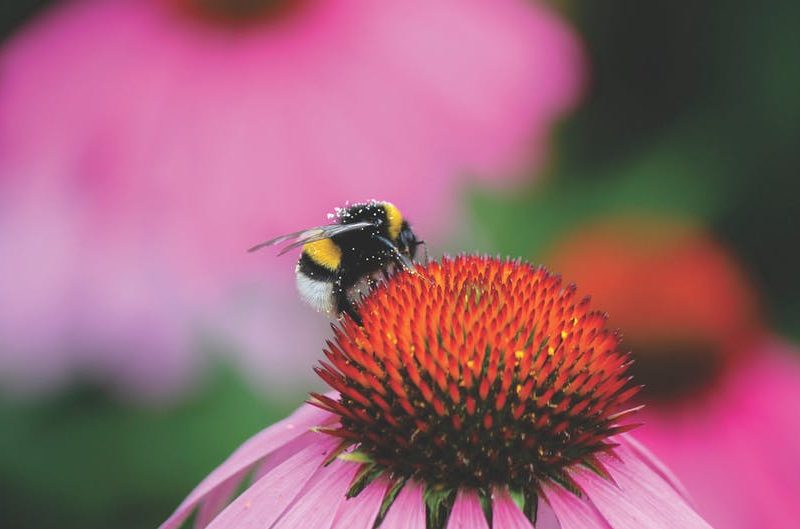Bumblebees Are Better Pollinators, But Also Are Disappearing
By Megan Hix
Reporting Texas

Bumblebee numbers are declining rapidly, and four of nine species in Texas are at risk. Matthias Zomer/Creative Commons
There’s been a lot of buzz in recent years about the decline of honeybee populations in the U.S. and its harmful effects on U.S. agriculture. Now researchers say an even more prodigious pollinator is in trouble—the fuzzy, ground-dwelling bumblebee.
The more common European honeybee, a non-native pollinator, adds an estimated $15 billion to the U.S. economy each year, according to a 2014 memorandum issued by the Obama administration. Other pollinators, including many bumblebee species, add another $9 billion.
Yet in recent years, native bees, including several Texas bumblebees, have become increasingly vulnerable to habitat loss primarily caused by a preponderance of single-crop agricultural and creeping urbanization, said Michael Warriner, a U.S. Fish and Wildlife Services supervisory biologist.
Warriner said even bumblebee species that aren’t at risk could be in trouble in 10 to 20 years if no action is taken. “Once a species reaches that point, you have the danger of it blinking out completely,” he said. “Especially with bees and pollinators, it’s a real danger because they are a foundational part of ecosystems.”
In Texas, bees pollinate key cash crops such as cotton and produce, including blueberries, melons and tomatoes. Because of their ability to “buzz pollinate,” or shake loose additional pollen by vibrating their wings, bumblebees make more effective pollinators than honeybees and other species, according to the U.S. Department of Agriculture.
In February, the Trump administration put plans on hold to add the rusty patched bumblebee to the U.S. endangered species list pending further review. Its inclusion would require the Environmental Protection Agency to develop a conservation plan.
While there are no rusty patched bumblebees in Texas, four of the state’s nine species are considered “at risk” by the International Union for Conservation of Nature, a global environmental organization that creates and monitors a “Red List” of threatened animal and plant species. That list includes the yellow, southern plains, American and variable cuckoo bumblebees. The variable cuckoo population has declined so sharply that it is now considered “critically endangered” in North America.
Unlike the hard-to-pinpoint cause of colony collapse disorder, which has decimated honeybee populations, the biggest threats to bumblebees are better understood. Bee biologist Shalene Jha said the shift of modern agricultural practices toward monoculture, or single-crop farming, means bees don’t have the variety of food necessary to sustain them.
If farmers designated part of their land to pollinator habitat, said Jha, an assistant professor in the University of Texas’ department of integrative biology, they could boost their own crop production while supporting bee populations. “You don’t need a lot of natural habitat to support bees. You just can’t eliminate all their natural habitat and assume they’ll still be around,” she said.
Neonicotinoid pesticides have also been linked to the bumblebee’s decline, Jha said, though there is still work to be done in determining if other types of pesticides are harming bee populations as well.
Texas is one of the leading agricultural producers in the U.S., behind only California and Iowa, according to the USDA. But the state’s urban areas are growing quickly. Five of the fastest-growing cities in the U.S. are in Texas, according to the Census Bureau.
Jessica Beckham, a postdoctoral researcher at the University of North Texas, said even small patches of land and personal gardens can act as “habitat islands,” supporting bees in otherwise uninhabitable urban environments. “As we take responsibility for these imperiled species, we need to make sure that our cities are providing some green spaces where these bees can forage,” she said.
Last year, the Texas Parks and Wildlife Department extended an agricultural tax credit to landowners who include pollinator habitats on their property. To qualify, owners typically grow varied types of flowers, weeds and grasses, as well as offer good nesting sites. Jha is working with researchers at UT, Oklahoma State University, the Texas Parks and Wildlife Department, U.S. Fish and Wildlife Services and the Oklahoma Department of Wildlife and Conservation to test the management recommendations over a three-year span.
Jha said the tax break is a good example of a “first step” for city and state governments to help conserve declining bee populations, especially if the Trump administration chooses not to protect the rusty patched and other bumblebee species.
“I think it is up to us on a local scale now to try and conserve these resources, even if the federal incentives are no longer present,” Jha said.